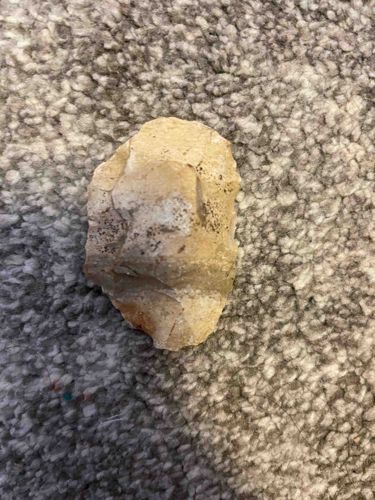
Stone Tool/Lithic Flake
The item appears to be a stone tool, specifically a lithic flake or core exhibiting evidence of human modification. Its overall physical characteristics suggest it is a piece of chert or flint, given its conchoidal fracture pattern and dull to slightly waxy luster in areas. The predominant color is a light, creamy beige or off-white, with significant variations including darker greyish-brown mottling and speckling, particularly in recessed or porous areas. There are visible striations and cleavage lines, indicating natural bedding planes or fractures within the original stone, further modified by knapping. The form is irregular and angular, consistent with a struck flake or a small core from which flakes have been removed. One edge exhibits a relatively sharp, possibly worked, margin, while other edges are more blunted or naturally fractured. There are no discernible manufacturing marks or signatures, consistent with prehistoric stone tool production. The surface shows some light wear and possibly a natural patina, which is common for artifacts exposed to the elements over long periods. The dark speckling might indicate mineral inclusions or encrustations. Its size cannot be accurately determined without a scale, but it appears small enough to be held comfortably in one hand. The craftsmanship indicates basic flaking techniques were applied, possibly for a simple cutting or scraping implement. Given the lack of advanced shaping, it could be a preliminary core or a primary flake.
AI-Generated Appraisal Disclaimer
Estimated Value
$25-75
Basic Information
Category
Lithic Artifact
Appraised On
November 29, 2025
Estimated Value
$25-75
Item Description
The item appears to be a stone tool, specifically a lithic flake or core exhibiting evidence of human modification. Its overall physical characteristics suggest it is a piece of chert or flint, given its conchoidal fracture pattern and dull to slightly waxy luster in areas. The predominant color is a light, creamy beige or off-white, with significant variations including darker greyish-brown mottling and speckling, particularly in recessed or porous areas. There are visible striations and cleavage lines, indicating natural bedding planes or fractures within the original stone, further modified by knapping. The form is irregular and angular, consistent with a struck flake or a small core from which flakes have been removed. One edge exhibits a relatively sharp, possibly worked, margin, while other edges are more blunted or naturally fractured. There are no discernible manufacturing marks or signatures, consistent with prehistoric stone tool production. The surface shows some light wear and possibly a natural patina, which is common for artifacts exposed to the elements over long periods. The dark speckling might indicate mineral inclusions or encrustations. Its size cannot be accurately determined without a scale, but it appears small enough to be held comfortably in one hand. The craftsmanship indicates basic flaking techniques were applied, possibly for a simple cutting or scraping implement. Given the lack of advanced shaping, it could be a preliminary core or a primary flake.
Related Tags
Get Your Items Appraised
Instant estimates of your treasures with AI-powered instant appraisals